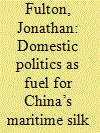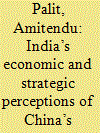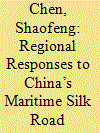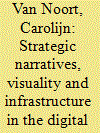|
|
|
Sort Order |
|
|
|
Items / Page
|
|
|
|
|
|
|
| Srl | Item |
| 1 |
ID:
171036


|
|
|
|
|
| Summary/Abstract |
This article sheds light on the factors shaping China’s Maritime Silk Road Initiative (MSRI) in small states through a study of Djibouti and the MSRI. It also analyses the establishment of China’s first overseas military base and thus evaluates the military-security implications of Chinese MSRI ports. Among other things, it shows that we need to conceive the locational value of MSRI participants more richly, that the existence of an authoritarian partner has advantages for China, but does not necessarily drive MSRI activities, and that small MSRI states have agency vis-à-vis China. It suggests, too, there is a template of Chinese port development and that it should not be assumed that China is intentionally wielding the ‘debt trap’ to gain equity.
|
|
|
|
|
|
|
|
|
|
|
|
|
|
|
|
| 2 |
ID:
158653


|
|
|
|
|
| Summary/Abstract |
There is raging speculation about the potential implications of China’s One Belt, One Road (OBOR)/Belt and Road Initiative (BRI) for the global order, spheres of influence and the positions of extra-regional powers. Much commentary is overly broad and lacks a clear and systematic method for examining OBOR/BRI’s future consequences. Focusing on the Maritime Silk Road Initiative (MSRI), a major OBOR/BRI component, in the Southeast Asian context, this article shows China’s own situation and Southeast Asian international and domestic economic and political variables will hinder the complete implementation of the MSRI. Even if the MSRI is fully realized, various factors will limit the political impact of the MSRI’s economic attractions. In short, the MSRI is more likely to yield a Chinese pond than a Chinese lake.
|
|
|
|
|
|
|
|
|
|
|
|
|
|
|
|
| 3 |
ID:
171035


|
|
|
|
|
| Summary/Abstract |
China’s involvement with the Gulf monarchies has been built upon an economic foundation. With the Belt and Road Initiative (BRI) and the Maritime Silk Road Initiative (MSRI) this has expanded, as the Gulf monarchies see cooperation with China through MSRI projects as a means of advancing economic development programs necessary to move beyond single-resource rentier economies and relationships with external powers as a means of ensuring their security in an unstable region. This has important implications for the shape of the MSRI as a whole, and how it fits together with the larger BRI. China’s BRI/MSRI success with participating states will be a matter of matching their specific domestic needs and strategic considerations with Chinese perceptions of the relative importance of those states.
|
|
|
|
|
|
|
|
|
|
|
|
|
|
|
|
| 4 |
ID:
153518


|
|
|
|
|
| Summary/Abstract |
The Maritime Silk Road Initiative (MSRI) is a part of China’s experiment in scaling up economic corridors across vast swathes of diverse economic geographies. China’s involvement in a large number of ongoing transport corridor projects has encouraged it to embark on the most ambitious of them all till date. The heterogeneity among the economic capacities and integrations of various regions constituting the MSRI, particularly in efficiency of infrastructure and ability to trade, is noticeable. This article underscores these variations as important determinants of competitiveness of the constituent regions and countries. India’s perceptions of the MSRI are significantly shaped by its lack of quality maritime infrastructure capacities that make it relatively uncompetitive vis-à-vis China, Europe and most of Southeast Asia; and the impression of the MSRI’s “China-centrality” emanating from lack of mention of non-China regional forums in the Chinese government’s vision statement; and absence of proactive measures from the Chinese leadership in establishing the MSRI’s multi-country character. The article argues that it is important for India to appreciate the geopolitical character of this unprecedented infrastructure initiative, which, while emphasizing Chinese interests, might not be inimical to India’s economic ambitions, provided India is able to address its domestic infrastructure imperatives.
|
|
|
|
|
|
|
|
|
|
|
|
|
|
|
|
| 5 |
ID:
158654


|
|
|
|
|
| Summary/Abstract |
Southeast Asia has sat atop China’s Maritime Silk Road Initiative (MSRI). By and large, most Southeast Asian countries hailed China’s MSRI, but their responses to it have some variances. The article aims to analyze why they have differing responses. It contends that the primary determinant is changing domestic politics, specifically, ruling elites’ policy priority, degree of trust of China, leaders’ ideology and preference, and social response. While rejecting the impact of trade imbalance and outward foreign direct investment (FDI) from China, the influence of the South China Sea dispute and America’s Asia policy have been partially verified.
|
|
|
|
|
|
|
|
|
|
|
|
|
|
|
|
| 6 |
ID:
179092


|
|
|
|
|
| Summary/Abstract |
Visual communication is at the heart of international relations in the digital age. Using a range of media tools, political elites communicate so-called ‘strategic narratives’ to persuade and influence the behaviour of target audiences. The existing body of research on ‘strategic narratives’ examines both spoken and written messages. While an academic focus on visual texts is emerging, limited attention has been given to the visualization of peaceful topics such as infrastructure projects. This paper examines the ontological and methodological foundations of ‘strategic narratives’, ‘visuality’, and ‘infrastructure’, to ascertain what seeing strategic narratives on infrastructure means in the study of global politics. The theoretical claims are demonstrated using the case study of China’s Maritime Silk Road Initiative. Herein, it is shown how China communicates strategic narratives on infrastructure to persuade target audiences of its foreign policy priorities, and to secure its self-concept. This communication process is supported by images in the digital sphere.
|
|
|
|
|
|
|
|
|
|
|
|
|
|
|
|
|
|
|
|
|